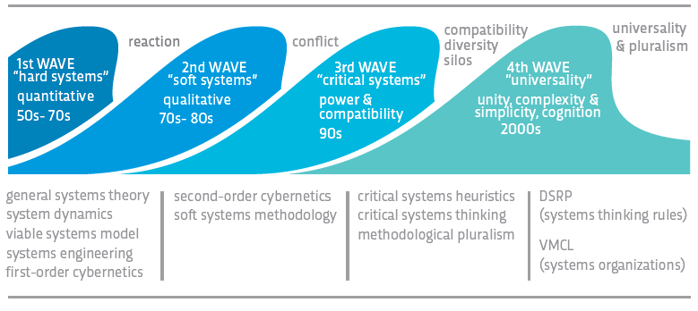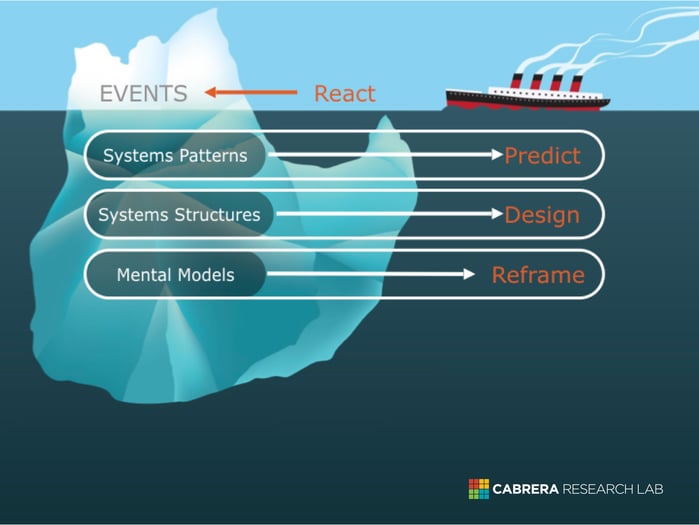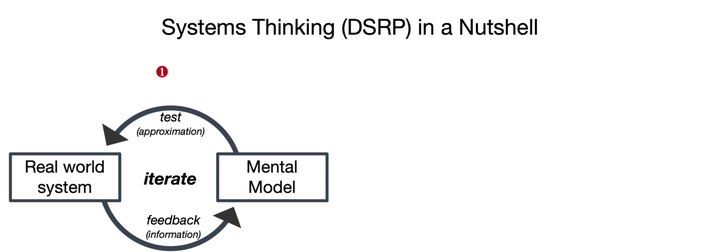Systems Thinking in Seven (7) Images
 Derek & Laura Cabrera
·
3 minute read
Derek & Laura Cabrera
·
3 minute read
1. The MFS Universe answers the question, "What is included when we say Systems Thinking?" MFS is an acronym that stands for Midgley, Francois, Schwartz (See more on this here). This image tells us that when we say "Systems Thinking" we are referencing literally thousands of different approaches, methods, scholars, theorists, ideas, frameworks, etc.

2. The 4 Waves of Systems Thinking provides a summary of the history of Systems Thinking as a field, writ large. The 4 waves were originally conceived by Flood and Jackson* (1991), and subsequently developed by Midgley and Cabrera who propose that this history resembles versions more than waves (i.e., v1.0, ..., v4.0). The waves include all of the items in the MFS Universe but show how (and why) they occurred in time. Thus, The image below shows just a few examples of methods or frameworks in each wave—there are countless more.

3. The next infographic you need is VUCA-LAMO. VUCA-LAMO are two acronyms that stand for Volatile, Uncertain, Complex, and Ambiguous and Linear Anthropocentric, Mechanistic, and Ordered. VUCA adequately describes the real world and LAMO adequately describes our current manner of thinking about the world.
.png?width=697&name=Untitled%20presentation%20(3).png)
The VUCA-LAMO infographic illustrates how our thinking is mismatched with the real world. It illustrates that we need a new way of thinking, and therefore answers the question, "Why Systems Thinking?" The answer: Because the world is VUCA but our thinking is LAMO. Most importantly, wicked problems result from the mismatch between how real-world systems work and how we think they work.
4. Image #4 on our list is called the "Systems Thinking Iceberg" (or "ST Berg"). The "berg" is critically important because where VUCA-LAMO shows us WHY systems thinking is needed, the "berg" shows us specifically WHAT systems thinking does. It asks us to look deeper (Kahneman System 2 style). Deeper than what, at what?

Deeper than the information and events we see at the surface, that cause us to react. Deeper to the systems patterns of repeating events that allow us to do more than just react, but to predict. Even deeper to the systemic structures that determine the behavior (good or bad) of a system and therefore allow us to design new system structures to yield new behaviors. And finally, deeper to the mental models through which we see (and bias) all systems, which in turn allows us to reframe the way we are seeing and understanding the system.
5. The "Systems Thinking Loop" (or "ST Loop") is where the rubber meets the road for systems thinkers. It is perhaps the most important of all the images because it describes WHAT systems thinking really is and HOW to do it. It is best to digest this image (Systems thinking itself) in three bites (red):

- The ST Loop itself, which explains that all mental models are wrong but some are useful. Their utility is predicated on the degree to which they approximate the real-world which is determined by testing them in the real world and receiving feedback in the form of information.
- M=I x T, which explains that our mental models (M) are made up of the information (I) we receive from the real-world (through a veil of DSRP by the way—called "Reality Bias") and thinking (T).
- Defines specifically what we mean by information (I) and thinking (T) by defining, in particular, the universal patterns of thinking that underlie all systems thinking and cognition.
In a nutshell, we see that Systems Thinking isn't something you do, but something you get. It is a complex adaptive system or CAS, the emergent property of which is Systems Thinking. You get Systems Thinking by doing DSRP (simple rules).
And, it builds off of the previous images: it strikes at the essence of the ST Iceberg by getting at mental models and systems structures/patterns/events (i.e., real-world); and it gets at the VUCA-LAMO model by ensuring that our mental models are tested against real-world phenomena repetitively and also by replacing LAMO thinking with DSRP—the universal patterns that underlie the MFS Universe and the 4 Waves.
6. The ST-SL Pyramid illustrates the deep connection between Systems Thinking (ST) and Systems Leadership (SL). Systems Thinking (DSRP) drives not only individual learning but also organizational Learning. This in turn drives organizational Capacity to do the organization's Mission (repeated actions) which brings about the organizational Vision (the desired goal state). These four functions—VMCL— are universal to all organization (see VMCL Amoeba).
.png?width=696&name=Untitled%20presentation%20(2).png)
So we see that DSRP is the basis for Systems Thinking—Systems Thinking is the basis for Systems Leadership—VMCL is the basis for Systems Leadership.
7. The final image depicts VMCL Dynamics to show how organizational Learning drives Capacity, Mission, and Vision, with feedback loops back to Learning.

Imagine another loop—the ST Loop—occurring inside the Learning node.And remember that the the ST Loop and DSRP drives all learning, individually and for organizations.
These 7 images provide monkey bars through the landscape of systems thinking, the field (images 1&2), why its important (images 3&4), and how we become systems thinkers individually (images 5&6) and in organizations (6&7). They combine to make—Systems Thinking—simple.
*Flood, RL., and Jackson, MC. 1991. Critical Systems Thinking: Directed Readings. Chichester; New York: J. Wiley.
These concepts and images were adapted from these two books. If you would like to dive deeper into the content, they are linked below as well is our course on Systems Thinking:
.png?width=150&height=150&name=CRL%20GOAT%20Logo%20(4).png)




